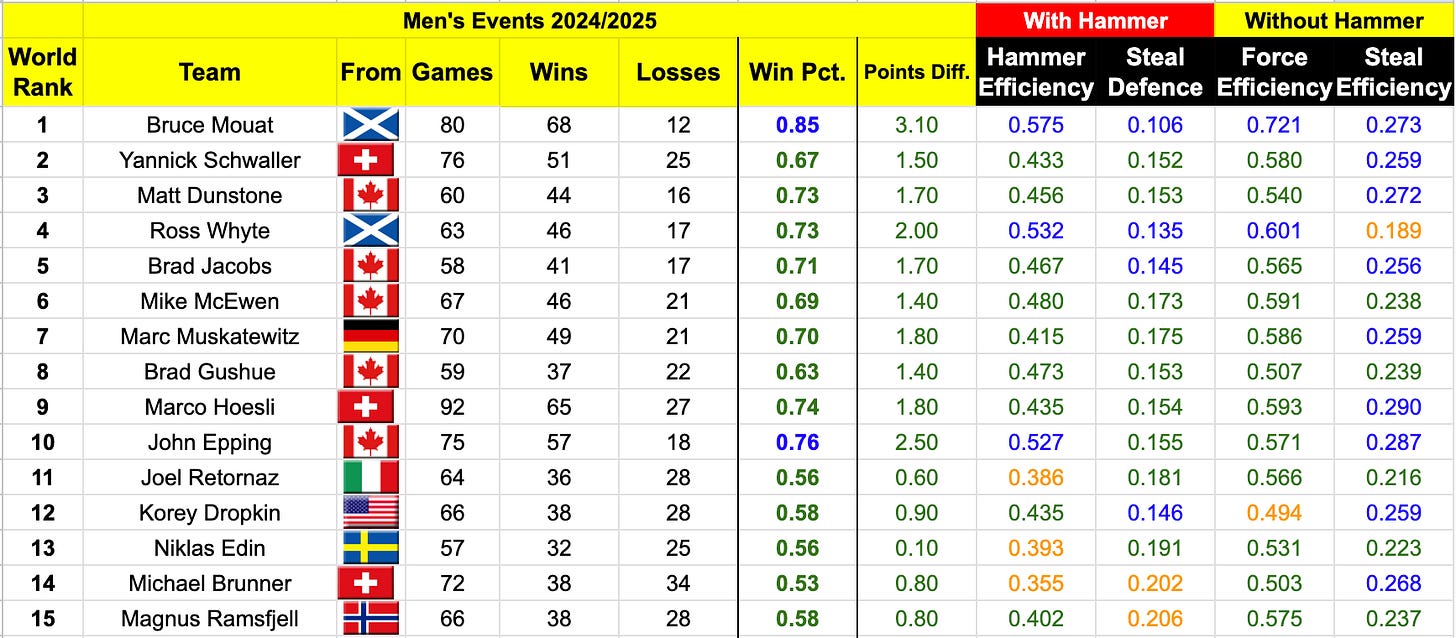Comparing the analytics of the top men's Curling Teams in the World
What do the best teams in the world do that is better than the rest? Here's a look at the analytics of the top 15 ranked Men's Teams in the world.
Team Mouat is the best of the best
(photo courtesy Grand Slam of Curling)
The latest World Curling Rankings are based on a teams’ best results for 8 events during the 2024-2025 Curling Season, and Scotland’s Bruce Mouat remains in the top spot by a long shot, with a 123 point lead over Switzerland’s Yannick Schwaller.
What is it that has Mouat so far ahead of his rivals in the World Ranking? And what separates these elite teams from the hundreds of other elite teams that are trying to get to the top of this list?
First, I would like to thank Ken Pomeroy of doubletakeout.com and doubletakeout.substack.com for tracking the linescores and analytics for all of the teams playing all of the major events in the world throughout the season.
And of course, curlingzone.com for calculating and updating the World Rankings each week.
The analytics show that Team Mouat is the best in the business in a few different areas. First, they have outscored their opponents by an average of 3.1 points in the 80 games they have played this season, and they have a winning percentage of .85, which is .09 higher than their nearest competitor.
They have the highest Hammer Efficiency, the lowest Steal Defence, and the highest Force Efficiency of any of the top 15 teams in the world.
That makes them the best team in the world, both with, and without the hammer.
A With Hammer Index of .469
You can see Team Mouat’s dominance even more clearly when you take a look at those numbers in a little different way. If you take a Team’s Hammer Efficiency and subtract it’s Steal Defence from that number, it will show you how well a team plays when it has the hammer. And Team Mouat’s With Hammer Index of .469 is far and away the best of the top 15 ranked teams in the world.
The next best team in that category is Scotland’s Ross Whyte, and Team Whyte is playing even better than Team Mouat right now, having just won the WFG Masters Grand Slam, and the Scottish National Men’s Championship by beating Mouat in the final last week.
You can expect Whyte to keep moving up in the World Rankings, especially if Scotland chooses him over Mouat to represent Scotland in the upcoming World Men’s Curling Championship.
A Without Hammer Index of .994
Team Mouat is also the best in the world playing without the hammer. When you add their incredible Force Efficiency number of .721 to their Steal Efficiency of .273, it gives them a Without Hammer Index of .994, which is .111 better than their nearest competitor, 9th ranked Marco Hoesli of Switzerland.
A Team Index of 1.463
When you add Team Mouat’s With Hammer Index of .469 and it’s Without Hammer Index of .994, it gives them a Team Index of 1.463, which is .343 higher than the 2nd ranked team in the world, Switzerland’s Yannick Schwaller, and .233 higher than the next best Team in that category, Canada’s John Epping, which is ranked 10th in the world right now.
A Team Efficiency of 2.313
When you take Team Mouat’s Team Index of 1.463, and add it’s Winning Percentage of .850, you get what I call a Team Efficiency number of 2.313, which is .522 ahead of Schwaller, and .396 ahead of the fast-charging Whyte.
You can see the analytics for all of the top men’s teams in the world by clicking on the following link - Men’s Analytics 2024/2025
I’ll be comparing the analytics for the top Women’s Teams in the world next week so stay tuned and thanks for following along!
Definitions
Hammer Efficiency
(Hammer Efficiency is calculated by dividing the number of ends with hammer where you scored at least 2 points, divided by the total number of ends you had hammer where points were scored by either team. Blank ends are not counted.)
Steal Defence
(Steal Defence is calculated by dividing the number of stolen ends by the number of ends that a team had hammer. Blank ends are included.)
Force Efficiency
(Force Efficiency is calculated by dividing the number of ends where your opponent had hammer and scored only 1 point, by the total number of ends where they had hammer and scored in that end. Stolen or blank ends are not included in the calculation.)
Steal Efficiency
(Steal Efficiency is calculated by dividing the number of ends stolen by the total number of ends played without hammer. Blank ends are included.)











